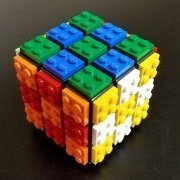Search the Community
Showing results for tags 'f7'.
Found 1 result
-
The EMD F7 was the SD40-2 of its day, the first true "common" diesel locomotive; thousands were built and could be found powering almost any train. When production had ended some 2,366 F7As and 1,483 F7Bs had been produced by 1953 just four years after the locomotive was first cataloged. According to an article by Don Strack, published in the November/December 1991 issue of "Diesel Era: Volume 2, Number 6" the, "base price on two cab units was $161,000 and the base price for two booster units was $147,500." This was also the first instance of the Electro-Motive Division's new General Motors Diesel (GMD) subsidiary filling orders. Read more from this article about this historic loco on this site. My model was inspired by the Union Pacific 1471 and 1476B pictured below. It was really the only photo I could find of a UP F7 A/B pair. My initial inspiration came after recently obtaining sets 10020, the Santa Fe Super Chief, and 10022, one each of the dining, sleeping and observation cars. I can see why they are so coveted, each is beautiful!I set about to modify 10020 in several ways to make it look better. I decided on the UP scheme because my dad left me his LGB scale UP loco when he passed (just like his LGB BNSF that inspired this build, here). I modified the sides and doors to more closely resemble the F7a and F7b units (which I'm presuming the 10020 was based on). While the windows are not round (yet) the vents between them, the doors, the grab rails, plus the square sand fill doors are all details I tried to capture more accurately than set 10020 did. Plus the battery box and fuel tank underneath look better. I decided to add twin train motors to the a-unit to propel it because my trains are heavy, my curves are tight and one motor just doesn't have the traction necessary (power yes, traction no). The PF receiver blends in nicely on the rear and the middle fan on top acts as a power switch. Seven of my eight locos have a concealed power "button" accessible from the outside, the Super Chief being my only one I have to remove the top on. Speaking of consistency between locos, my BNSF and CSX have a distinct side window look with the two vertical tiles. I'm considering that same look for my UP. The taped up windows look okay, especially from a few feet away, and while I like the slightly more detailed or scale appearance, the tape looks unfinished and I'm not sure it is necessary. I also applied minimal detailing on the inside. The b-unit got an engine you can see thru the windows and the a unit got a hint of an engine hidden in amongst the wires. The lettering and numbering I did myself on my inkjet printer using Testors decal paper. They are applied wet then they dry nice and smooth. As usual I'll share my LDD file for anyone who wants to examine, build or modify my design. I'll upload that soon. Here you go. https://bricksafe.com/pages/sed6 Hope you like! Edit: just realized I didn't print the X1471 decals that go by the headlights for the nose! Also in the pic above the stickers peeling off are actually just static cling stickers, they work well enough but show some bubbles and don't handle tight radius curves like on the nose. The final water-slide decals are applied in all the above pictures, except this one.
- 9 replies
-
- super chief
- 10022
-
(and 4 more)
Tagged with:

